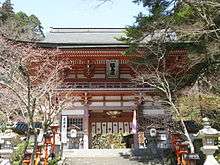Kurama-dera
Kurama-dera (鞍馬寺) is a temple in the far north of Kyoto, Japan which houses some National Treasures of Japan. It was a member of the Tendai sect and subordinate to Shōren-in from the 12th century until 1949 when it founded its own religious body. The object of worship is esoteric and unique to the temple. It is said to have been founded by a disciple of Jianzhen.
| Kurama-dera | |
|---|---|
鞍馬寺 | |
 The main entrance | |
| Religion | |
| Affiliation | Independent (Kuramakōkyō) |
| Deity | Sonten (union of Vaiśravaṇa, Kannon, Defender Lord) |
| Location | |
| Location | Sakyō-ku Kurama Honmachi 1074, Kyoto |
| Country | Japan |
| Geographic coordinates | 35°7′5.02″N 135°46′14.67″E |
| Architecture | |
| Founder | Jiànzhēn (鑑禎) |
| Completed | 770? |
Situated in secluded wilderness at the base of Mount Kurama, it is accessible by its own cable car line, the Kurama-dera Cable.
History
The temple was founded in the 8th century AD. Its origins are historically unclear, but it is said that the Chinese monk Jianzhen initiated a disciple into the Buddhist path, who saw in a dream in 772 that Mount Kurama had a spiritual power and built an esoteric temple to concentrate and control this power. It was burned down many times throughout the medieval era but the Buddhist statues and treasures inside it were always rescued and are today National Treasures. It is still believed today that tengu and other mountain spirits live in this area.
The temple switched between three different Buddhist sects over the centuries. Finally, in the postwar era, abbot Kouun Shigaraki founded his own religion and split the temple away from Buddhism. Thus the temple was finally able to reconcile with its yamabushi patrons and other unaffiliated, esoteric adherents of mountain worship.
Object of worship
The original objects of worship under the Tendai order were Bishamonten, protector of the north, and the Thousand-Armed Kannon. However, in the worship hall another statue has been added to these two, which the current leadership says creates a trinity called the "Sonten". Bishamonten represents the Sun, Kannon represents Love, and the third statue, the Defender Lord, represents Power, together being the "Spiritual Kings of the World". The Defender Lord came from Venus 6.5 million years ago and is eternally 16 years old due to chemical differences in the atmospheres of the two planets. Some New Age writers identify the Defender Lord with Sanat Kumara.
The actual objects of worship are ordinarily concealed from view, but visitors can see replicas of all three images in the main building. The replica of the Defender Lord depicts a xian-like figure with a long beard, a big nose, wings, and a halo made of leaves. It is thought that the tengu in the area proceed from this Defender Lord.
Tourism
It is an extremely popular temple for Japanese people to visit, owing to the many mysteries and occult events surrounding it, but does not appear in most English language guidebooks. It does appear in the 14th edition of Lonely Planet Japan as a Kyoto Highlight.[1]
Yuki-jinja

There is a famous Shinto shrine on the grounds of the temple called Yuki-jinja, which was founded in the year 940.
References
- Lonely Planet Japan 14th edition
- 信楽香仁『天狗の山 くらまだより』、大東出版社、1990
- 井上靖、塚本善隆監修、遠藤周作、信楽香仁著『古寺巡礼京都27 鞍馬寺』、淡交社、1978
- 竹村俊則『昭和京都名所図会 洛北』駸々堂、1982
- 『週刊朝日百科 日本の国宝』13号(鞍馬寺ほか)、朝日新聞社、1997
- 『日本歴史地名大系 京都市の地名』、平凡社
- 『角川日本地名大辞典 京都府』、角川書店
- 『国史大辞典』、吉川弘文館
External links
| Wikimedia Commons has media related to Kurama-dera. |
- (in Japanese) Yuki-jinja homepage
- (in Japanese) Kurama-dera homepage